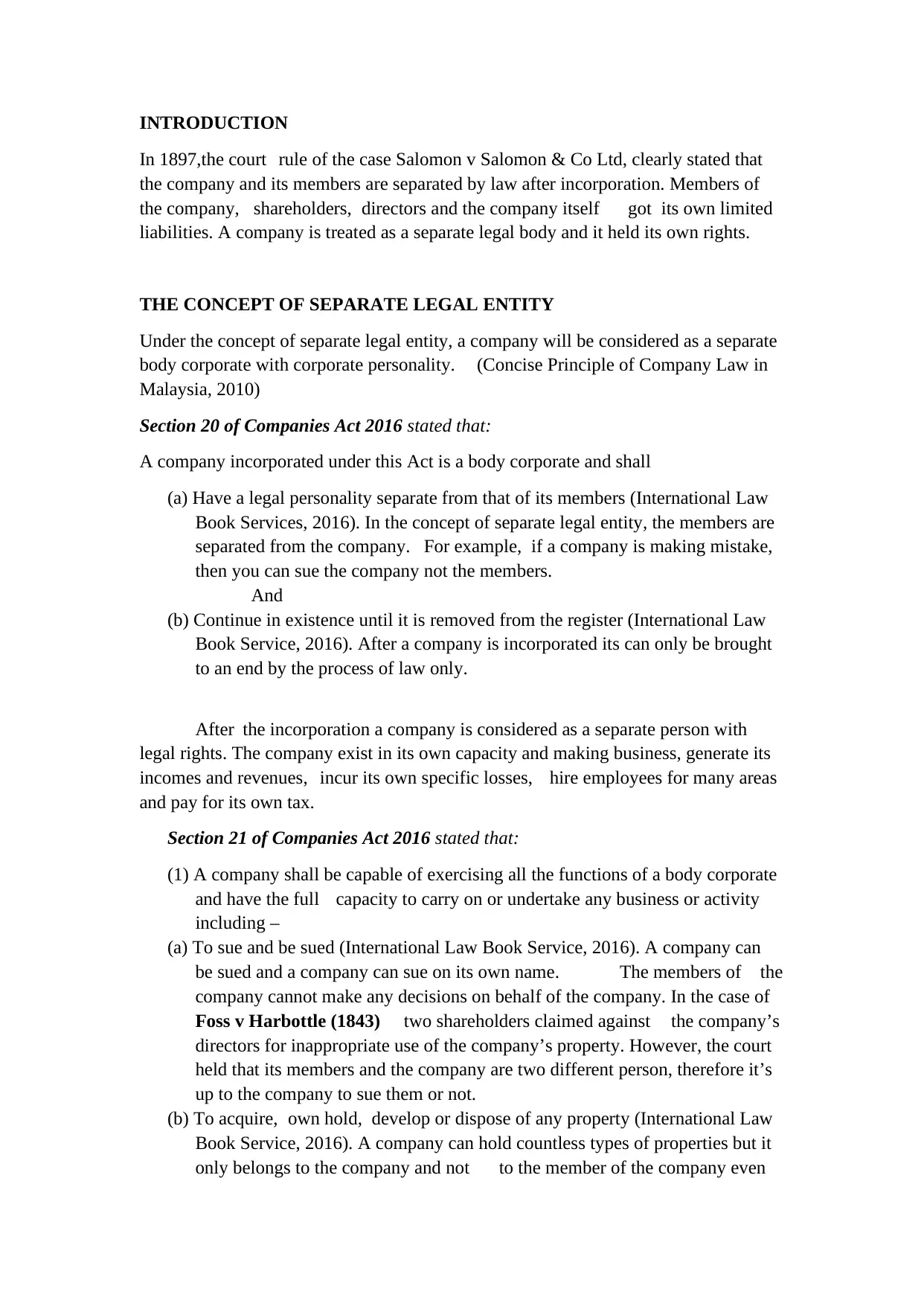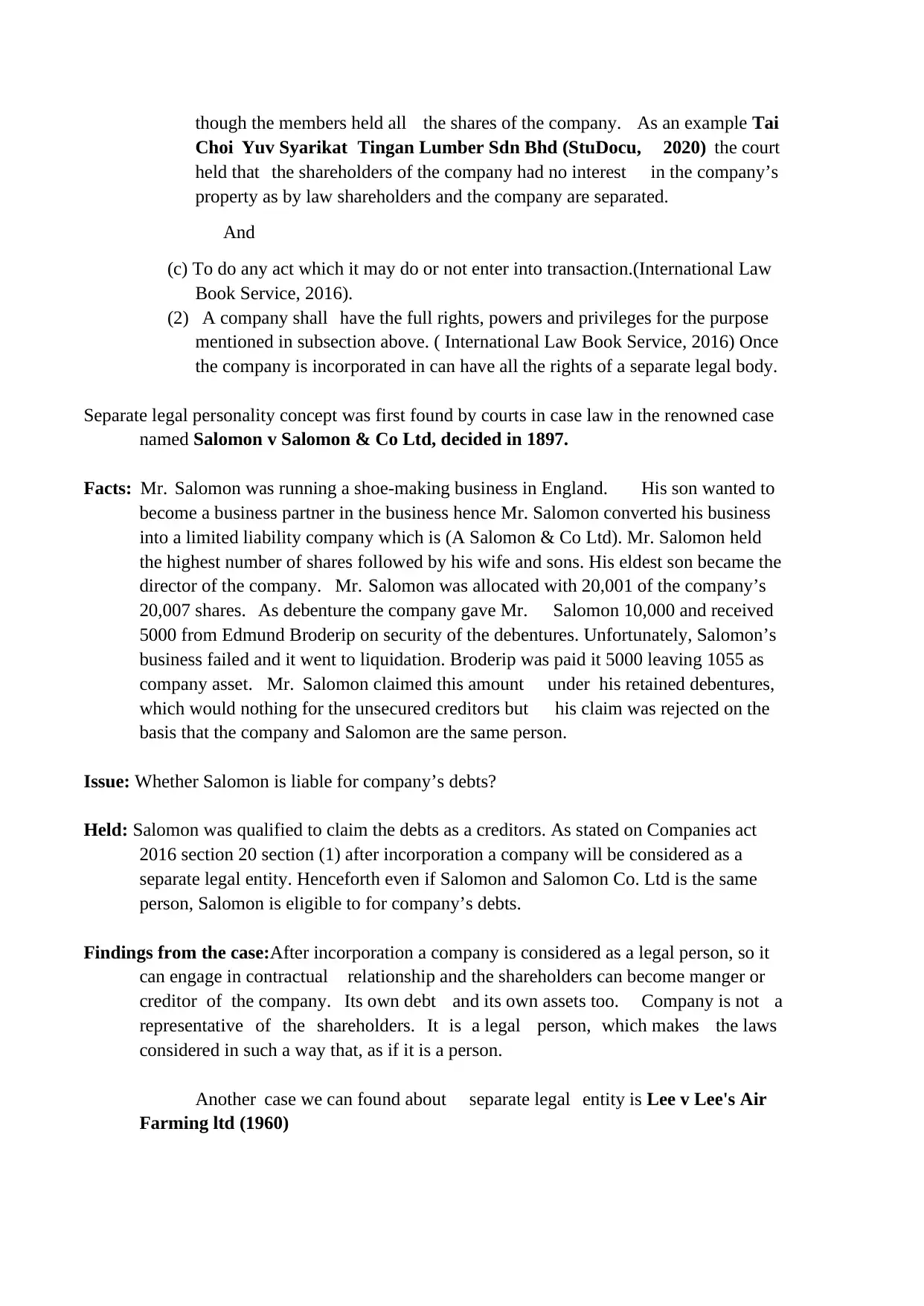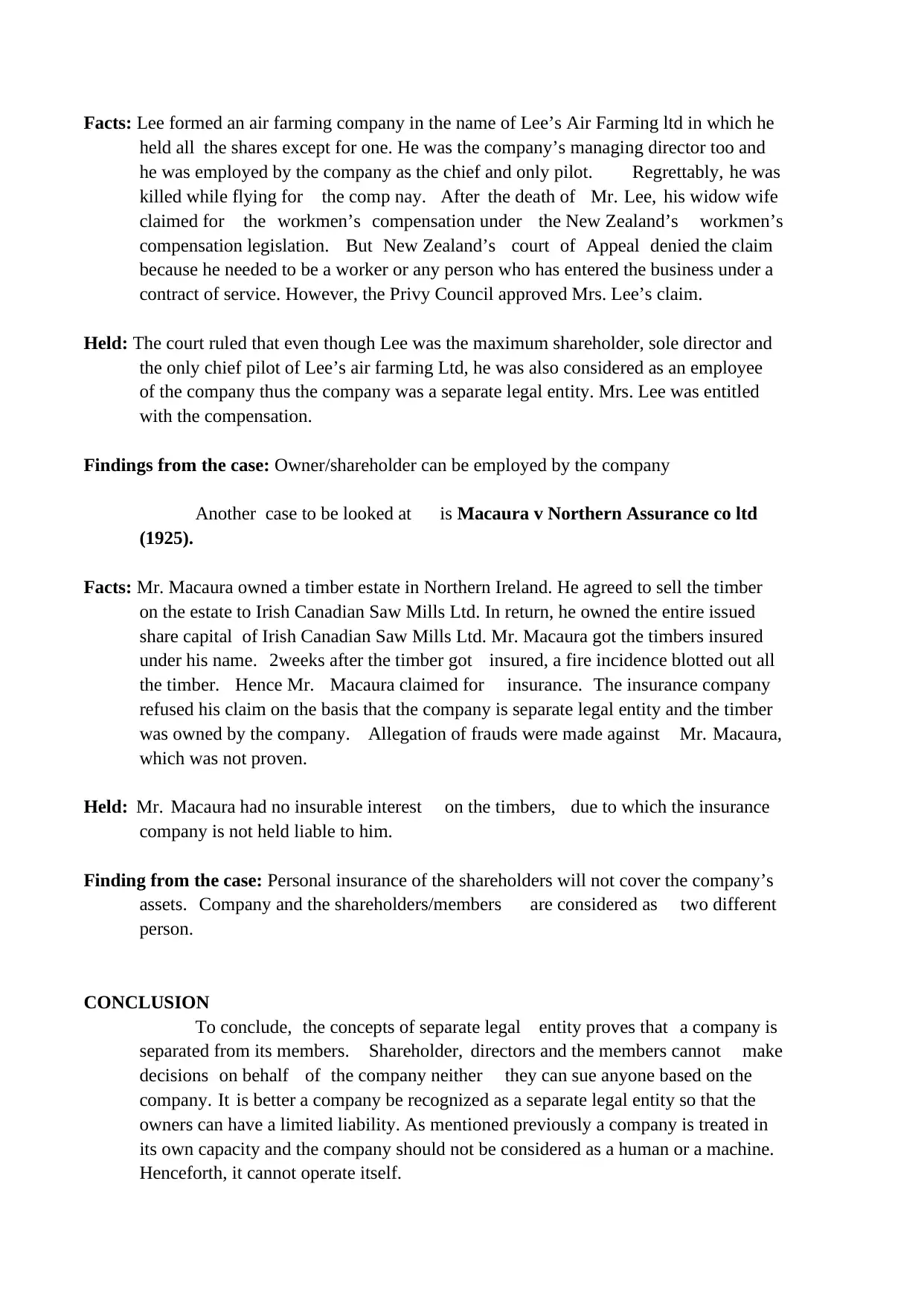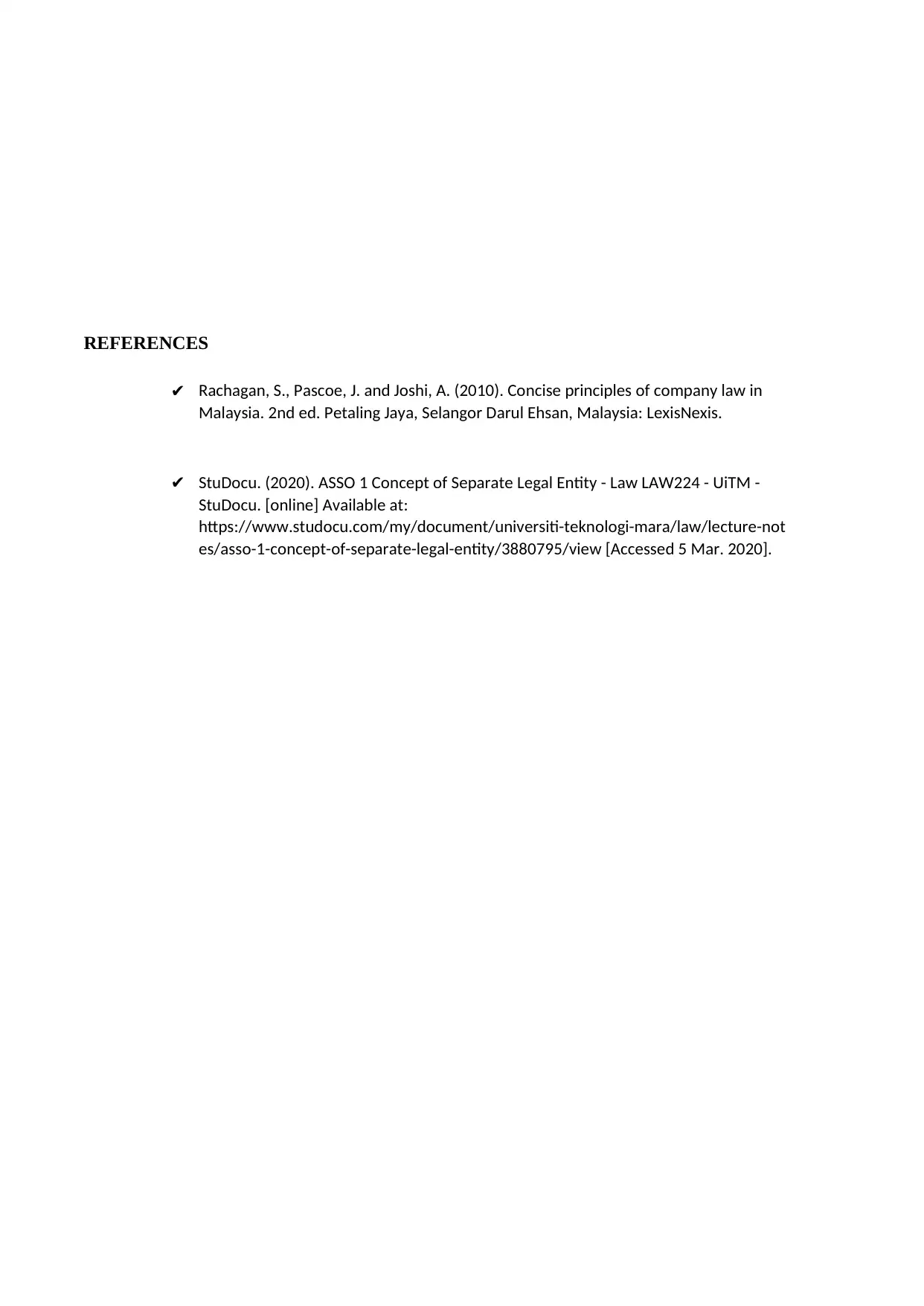Analysis of Separate Legal Entity Doctrine in Company Law
VerifiedAdded on 2023/01/13
|4
|1535
|92
Report
AI Summary
This report examines the concept of separate legal entity in company law, a fundamental principle established by the landmark case of Salomon v Salomon & Co Ltd. It elucidates that a company, upon incorporation, gains a legal personality distinct from its members, including shareholders and directors, thus conferring limited liability. The report delves into Section 20 and 21 of the Companies Act 2016. The report analyzes key case studies, including Lee v Lee's Air Farming Ltd and Macaura v Northern Assurance Co Ltd, to illustrate the implications of separate legal entity concerning company liabilities, ownership of assets, and the ability of shareholders to act on behalf of the company. The conclusion emphasizes the importance of recognizing companies as separate entities to protect owners and facilitate business operations, highlighting the distinction between the company's actions and those of its members.

INTRODUCTION
In 1897,the court rule of the case Salomon v Salomon & Co Ltd, clearly stated that
the company and its members are separated by law after incorporation. Members of
the company, shareholders, directors and the company itself got its own limited
liabilities. A company is treated as a separate legal body and it held its own rights.
THE CONCEPT OF SEPARATE LEGAL ENTITY
Under the concept of separate legal entity, a company will be considered as a separate
body corporate with corporate personality. (Concise Principle of Company Law in
Malaysia, 2010)
Section 20 of Companies Act 2016 stated that:
A company incorporated under this Act is a body corporate and shall
(a) Have a legal personality separate from that of its members (International Law
Book Services, 2016). In the concept of separate legal entity, the members are
separated from the company. For example, if a company is making mistake,
then you can sue the company not the members.
And
(b) Continue in existence until it is removed from the register (International Law
Book Service, 2016). After a company is incorporated its can only be brought
to an end by the process of law only.
After the incorporation a company is considered as a separate person with
legal rights. The company exist in its own capacity and making business, generate its
incomes and revenues, incur its own specific losses, hire employees for many areas
and pay for its own tax.
Section 21 of Companies Act 2016 stated that:
(1) A company shall be capable of exercising all the functions of a body corporate
and have the full capacity to carry on or undertake any business or activity
including –
(a) To sue and be sued (International Law Book Service, 2016). A company can
be sued and a company can sue on its own name. The members of the
company cannot make any decisions on behalf of the company. In the case of
Foss v Harbottle (1843) two shareholders claimed against the company’s
directors for inappropriate use of the company’s property. However, the court
held that its members and the company are two different person, therefore it’s
up to the company to sue them or not.
(b) To acquire, own hold, develop or dispose of any property (International Law
Book Service, 2016). A company can hold countless types of properties but it
only belongs to the company and not to the member of the company even
In 1897,the court rule of the case Salomon v Salomon & Co Ltd, clearly stated that
the company and its members are separated by law after incorporation. Members of
the company, shareholders, directors and the company itself got its own limited
liabilities. A company is treated as a separate legal body and it held its own rights.
THE CONCEPT OF SEPARATE LEGAL ENTITY
Under the concept of separate legal entity, a company will be considered as a separate
body corporate with corporate personality. (Concise Principle of Company Law in
Malaysia, 2010)
Section 20 of Companies Act 2016 stated that:
A company incorporated under this Act is a body corporate and shall
(a) Have a legal personality separate from that of its members (International Law
Book Services, 2016). In the concept of separate legal entity, the members are
separated from the company. For example, if a company is making mistake,
then you can sue the company not the members.
And
(b) Continue in existence until it is removed from the register (International Law
Book Service, 2016). After a company is incorporated its can only be brought
to an end by the process of law only.
After the incorporation a company is considered as a separate person with
legal rights. The company exist in its own capacity and making business, generate its
incomes and revenues, incur its own specific losses, hire employees for many areas
and pay for its own tax.
Section 21 of Companies Act 2016 stated that:
(1) A company shall be capable of exercising all the functions of a body corporate
and have the full capacity to carry on or undertake any business or activity
including –
(a) To sue and be sued (International Law Book Service, 2016). A company can
be sued and a company can sue on its own name. The members of the
company cannot make any decisions on behalf of the company. In the case of
Foss v Harbottle (1843) two shareholders claimed against the company’s
directors for inappropriate use of the company’s property. However, the court
held that its members and the company are two different person, therefore it’s
up to the company to sue them or not.
(b) To acquire, own hold, develop or dispose of any property (International Law
Book Service, 2016). A company can hold countless types of properties but it
only belongs to the company and not to the member of the company even
Paraphrase This Document
Need a fresh take? Get an instant paraphrase of this document with our AI Paraphraser

though the members held all the shares of the company. As an example Tai
Choi Yuv Syarikat Tingan Lumber Sdn Bhd (StuDocu, 2020) the court
held that the shareholders of the company had no interest in the company’s
property as by law shareholders and the company are separated.
And
(c) To do any act which it may do or not enter into transaction.(International Law
Book Service, 2016).
(2) A company shall have the full rights, powers and privileges for the purpose
mentioned in subsection above. ( International Law Book Service, 2016) Once
the company is incorporated in can have all the rights of a separate legal body.
Separate legal personality concept was first found by courts in case law in the renowned case
named Salomon v Salomon & Co Ltd, decided in 1897.
Facts: Mr. Salomon was running a shoe-making business in England. His son wanted to
become a business partner in the business hence Mr. Salomon converted his business
into a limited liability company which is (A Salomon & Co Ltd). Mr. Salomon held
the highest number of shares followed by his wife and sons. His eldest son became the
director of the company. Mr. Salomon was allocated with 20,001 of the company’s
20,007 shares. As debenture the company gave Mr. Salomon 10,000 and received
5000 from Edmund Broderip on security of the debentures. Unfortunately, Salomon’s
business failed and it went to liquidation. Broderip was paid it 5000 leaving 1055 as
company asset. Mr. Salomon claimed this amount under his retained debentures,
which would nothing for the unsecured creditors but his claim was rejected on the
basis that the company and Salomon are the same person.
Issue: Whether Salomon is liable for company’s debts?
Held: Salomon was qualified to claim the debts as a creditors. As stated on Companies act
2016 section 20 section (1) after incorporation a company will be considered as a
separate legal entity. Henceforth even if Salomon and Salomon Co. Ltd is the same
person, Salomon is eligible to for company’s debts.
Findings from the case:After incorporation a company is considered as a legal person, so it
can engage in contractual relationship and the shareholders can become manger or
creditor of the company. Its own debt and its own assets too. Company is not a
representative of the shareholders. It is a legal person, which makes the laws
considered in such a way that, as if it is a person.
Another case we can found about separate legal entity is Lee v Lee's Air
Farming ltd (1960)
Choi Yuv Syarikat Tingan Lumber Sdn Bhd (StuDocu, 2020) the court
held that the shareholders of the company had no interest in the company’s
property as by law shareholders and the company are separated.
And
(c) To do any act which it may do or not enter into transaction.(International Law
Book Service, 2016).
(2) A company shall have the full rights, powers and privileges for the purpose
mentioned in subsection above. ( International Law Book Service, 2016) Once
the company is incorporated in can have all the rights of a separate legal body.
Separate legal personality concept was first found by courts in case law in the renowned case
named Salomon v Salomon & Co Ltd, decided in 1897.
Facts: Mr. Salomon was running a shoe-making business in England. His son wanted to
become a business partner in the business hence Mr. Salomon converted his business
into a limited liability company which is (A Salomon & Co Ltd). Mr. Salomon held
the highest number of shares followed by his wife and sons. His eldest son became the
director of the company. Mr. Salomon was allocated with 20,001 of the company’s
20,007 shares. As debenture the company gave Mr. Salomon 10,000 and received
5000 from Edmund Broderip on security of the debentures. Unfortunately, Salomon’s
business failed and it went to liquidation. Broderip was paid it 5000 leaving 1055 as
company asset. Mr. Salomon claimed this amount under his retained debentures,
which would nothing for the unsecured creditors but his claim was rejected on the
basis that the company and Salomon are the same person.
Issue: Whether Salomon is liable for company’s debts?
Held: Salomon was qualified to claim the debts as a creditors. As stated on Companies act
2016 section 20 section (1) after incorporation a company will be considered as a
separate legal entity. Henceforth even if Salomon and Salomon Co. Ltd is the same
person, Salomon is eligible to for company’s debts.
Findings from the case:After incorporation a company is considered as a legal person, so it
can engage in contractual relationship and the shareholders can become manger or
creditor of the company. Its own debt and its own assets too. Company is not a
representative of the shareholders. It is a legal person, which makes the laws
considered in such a way that, as if it is a person.
Another case we can found about separate legal entity is Lee v Lee's Air
Farming ltd (1960)

Facts: Lee formed an air farming company in the name of Lee’s Air Farming ltd in which he
held all the shares except for one. He was the company’s managing director too and
he was employed by the company as the chief and only pilot. Regrettably, he was
killed while flying for the comp nay. After the death of Mr. Lee, his widow wife
claimed for the workmen’s compensation under the New Zealand’s workmen’s
compensation legislation. But New Zealand’s court of Appeal denied the claim
because he needed to be a worker or any person who has entered the business under a
contract of service. However, the Privy Council approved Mrs. Lee’s claim.
Held: The court ruled that even though Lee was the maximum shareholder, sole director and
the only chief pilot of Lee’s air farming Ltd, he was also considered as an employee
of the company thus the company was a separate legal entity. Mrs. Lee was entitled
with the compensation.
Findings from the case: Owner/shareholder can be employed by the company
Another case to be looked at is Macaura v Northern Assurance co ltd
(1925).
Facts: Mr. Macaura owned a timber estate in Northern Ireland. He agreed to sell the timber
on the estate to Irish Canadian Saw Mills Ltd. In return, he owned the entire issued
share capital of Irish Canadian Saw Mills Ltd. Mr. Macaura got the timbers insured
under his name. 2weeks after the timber got insured, a fire incidence blotted out all
the timber. Hence Mr. Macaura claimed for insurance. The insurance company
refused his claim on the basis that the company is separate legal entity and the timber
was owned by the company. Allegation of frauds were made against Mr. Macaura,
which was not proven.
Held: Mr. Macaura had no insurable interest on the timbers, due to which the insurance
company is not held liable to him.
Finding from the case: Personal insurance of the shareholders will not cover the company’s
assets. Company and the shareholders/members are considered as two different
person.
CONCLUSION
To conclude, the concepts of separate legal entity proves that a company is
separated from its members. Shareholder, directors and the members cannot make
decisions on behalf of the company neither they can sue anyone based on the
company. It is better a company be recognized as a separate legal entity so that the
owners can have a limited liability. As mentioned previously a company is treated in
its own capacity and the company should not be considered as a human or a machine.
Henceforth, it cannot operate itself.
held all the shares except for one. He was the company’s managing director too and
he was employed by the company as the chief and only pilot. Regrettably, he was
killed while flying for the comp nay. After the death of Mr. Lee, his widow wife
claimed for the workmen’s compensation under the New Zealand’s workmen’s
compensation legislation. But New Zealand’s court of Appeal denied the claim
because he needed to be a worker or any person who has entered the business under a
contract of service. However, the Privy Council approved Mrs. Lee’s claim.
Held: The court ruled that even though Lee was the maximum shareholder, sole director and
the only chief pilot of Lee’s air farming Ltd, he was also considered as an employee
of the company thus the company was a separate legal entity. Mrs. Lee was entitled
with the compensation.
Findings from the case: Owner/shareholder can be employed by the company
Another case to be looked at is Macaura v Northern Assurance co ltd
(1925).
Facts: Mr. Macaura owned a timber estate in Northern Ireland. He agreed to sell the timber
on the estate to Irish Canadian Saw Mills Ltd. In return, he owned the entire issued
share capital of Irish Canadian Saw Mills Ltd. Mr. Macaura got the timbers insured
under his name. 2weeks after the timber got insured, a fire incidence blotted out all
the timber. Hence Mr. Macaura claimed for insurance. The insurance company
refused his claim on the basis that the company is separate legal entity and the timber
was owned by the company. Allegation of frauds were made against Mr. Macaura,
which was not proven.
Held: Mr. Macaura had no insurable interest on the timbers, due to which the insurance
company is not held liable to him.
Finding from the case: Personal insurance of the shareholders will not cover the company’s
assets. Company and the shareholders/members are considered as two different
person.
CONCLUSION
To conclude, the concepts of separate legal entity proves that a company is
separated from its members. Shareholder, directors and the members cannot make
decisions on behalf of the company neither they can sue anyone based on the
company. It is better a company be recognized as a separate legal entity so that the
owners can have a limited liability. As mentioned previously a company is treated in
its own capacity and the company should not be considered as a human or a machine.
Henceforth, it cannot operate itself.
⊘ This is a preview!⊘
Do you want full access?
Subscribe today to unlock all pages.

Trusted by 1+ million students worldwide

REFERENCES
✔ Rachagan, S., Pascoe, J. and Joshi, A. (2010). Concise principles of company law in
Malaysia. 2nd ed. Petaling Jaya, Selangor Darul Ehsan, Malaysia: LexisNexis.
✔ StuDocu. (2020). ASSO 1 Concept of Separate Legal Entity - Law LAW224 - UiTM -
StuDocu. [online] Available at:
https://www.studocu.com/my/document/universiti-teknologi-mara/law/lecture-not
es/asso-1-concept-of-separate-legal-entity/3880795/view [Accessed 5 Mar. 2020].
✔ Rachagan, S., Pascoe, J. and Joshi, A. (2010). Concise principles of company law in
Malaysia. 2nd ed. Petaling Jaya, Selangor Darul Ehsan, Malaysia: LexisNexis.
✔ StuDocu. (2020). ASSO 1 Concept of Separate Legal Entity - Law LAW224 - UiTM -
StuDocu. [online] Available at:
https://www.studocu.com/my/document/universiti-teknologi-mara/law/lecture-not
es/asso-1-concept-of-separate-legal-entity/3880795/view [Accessed 5 Mar. 2020].
1 out of 4
Related Documents
Your All-in-One AI-Powered Toolkit for Academic Success.
+13062052269
info@desklib.com
Available 24*7 on WhatsApp / Email
![[object Object]](/_next/static/media/star-bottom.7253800d.svg)
Unlock your academic potential
Copyright © 2020–2025 A2Z Services. All Rights Reserved. Developed and managed by ZUCOL.





